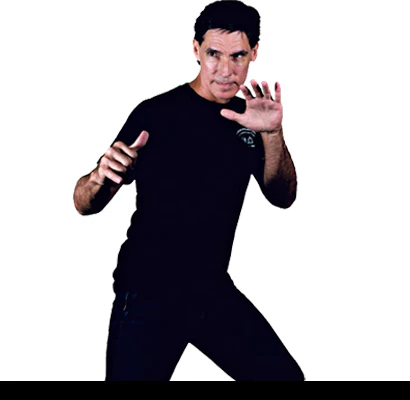Ground Fighting
Many martial artists ask me why I spend nearly half of my class working on ground fighting. Real fights often go to the ground, and if you have trained well on the ground you will greatly enhance your chances of finishing the fight in your favor. The fact is that in most self-defense situations, we prefer to avoid going to the ground. It is easier to escape from a standing position and you have a better chance (although it is still very difficult) to deal with multiple attackers successfully. Being on the ground, especially on your back, in a real fight is very, very dangerous. And that is exactly why we spend so much time practicing from that position. Another fact is that there are times when a fight is a one on one situation. This can be a challenge fight or a backyard brawl where some type of street etiquette is imposed. (This seems to be more common these days, where a group of people will encircle the two fighters and let them fight, almost like a mixed martial arts match in the street.) In these situations, the ability to fight on the ground can give you a huge advantage, even over someone much larger than yourself. Here are a few tips to help you with your ground fighting. The key to winning a ground fight is to get to and maintain a dominant position. From there, you can control the opponent while you work to finish the fight. In order to do this you must have good fighting skill on the ground. The all-important key to developing fighting skill, whether in kickboxing range, clinch range, or on the ground, is to actually practice applying your techniques against a partner who is fighting back. Just practicing techniques with a partner who offers no resistance will not prepare you for a real fight. A real attacker will fight your every attempt to subdue him, so you must practice your techniques against an uncooperative partner. It is much more fun too. You will learn how to get to that dominant position, hold the position, and finish the fight from there.There are many different positions in a ground fight. Each of the positions can be a Top or Bottom position. This makes the ground range different than kickboxing or clinch fighting. If you are kickboxing, both of you are trying to apply similar techniques. You both try to strike, get to the clinch, or shoot for a takedown. If you are in the clinch, you both try for similar moves, such as superior position, strikes, and takedowns. But on the ground, the person on top is going for different techniques than the person on the bottom. If you have achieved a dominant position like the mount (sitting on your downed opponent’s chest) you can strike hard, work for chokes, arm bars, arm locks, or move to his back. The person on the bottom has none of these options. He must try to get to a more favorable position. So while we categorize kickboxing and clinch as distinct ranges, ground fighting has to actually be looked at as two entities: ground game top and ground game bottom. Being on top is almost always better than being on the Bottom. (The only exception is if you are on your opponent’s back while your back is to the ground. He is on top, but you have a huge advantage.) You can strike harder from the top and you usually have better control over your opponent because you can use your weight to limit his movements. If you are on Top, you usually try to eliminate space to keep the opponent from moving to a better Position. If you are on the Bottom, you usually want to create space so that you can maneuver. If you want to effectively defend yourself, you must train to fight in all of the different ground positions. Ground fighting with striking is very different than just grappling. It is very tempting to only do submission grappling in your training without any strikes. This leads to bad habits. I highly encourage you to almost always allow strikes in your ground fighting practice. Do it safely with proper protective equipment, but make sure that striking is almost always part of your ground fighting training. In a real fight, a student who has trained ground fighting with striking for six months will almost always beat a person who has grappled for a year without adding strikes. In the street, the opponent will surely strike. If your primary goal is street self-defense, be sure to make ground fighting part of your practice. It will raise your confidence to a new level.Leave a comment
Comments will be approved before showing up.
